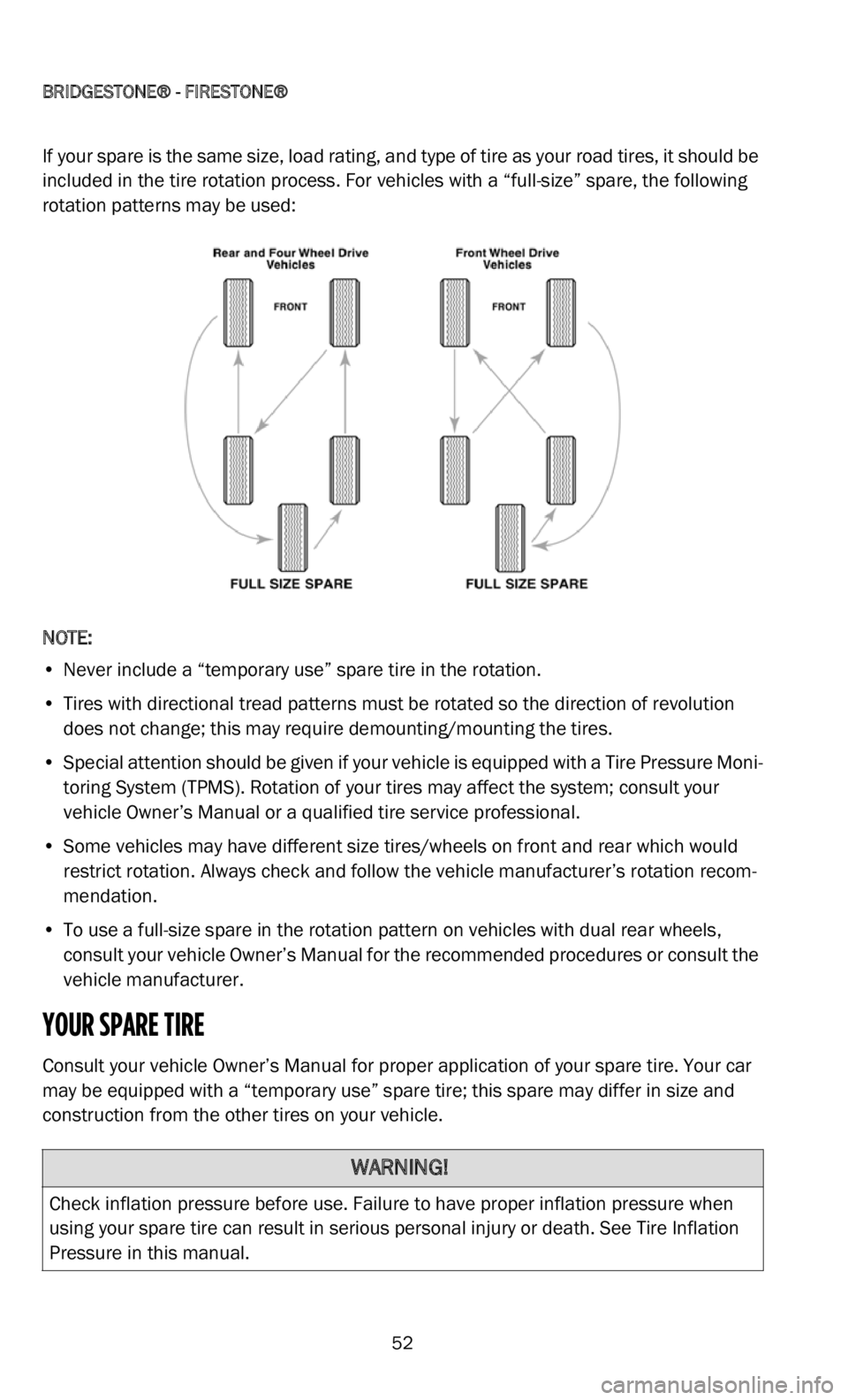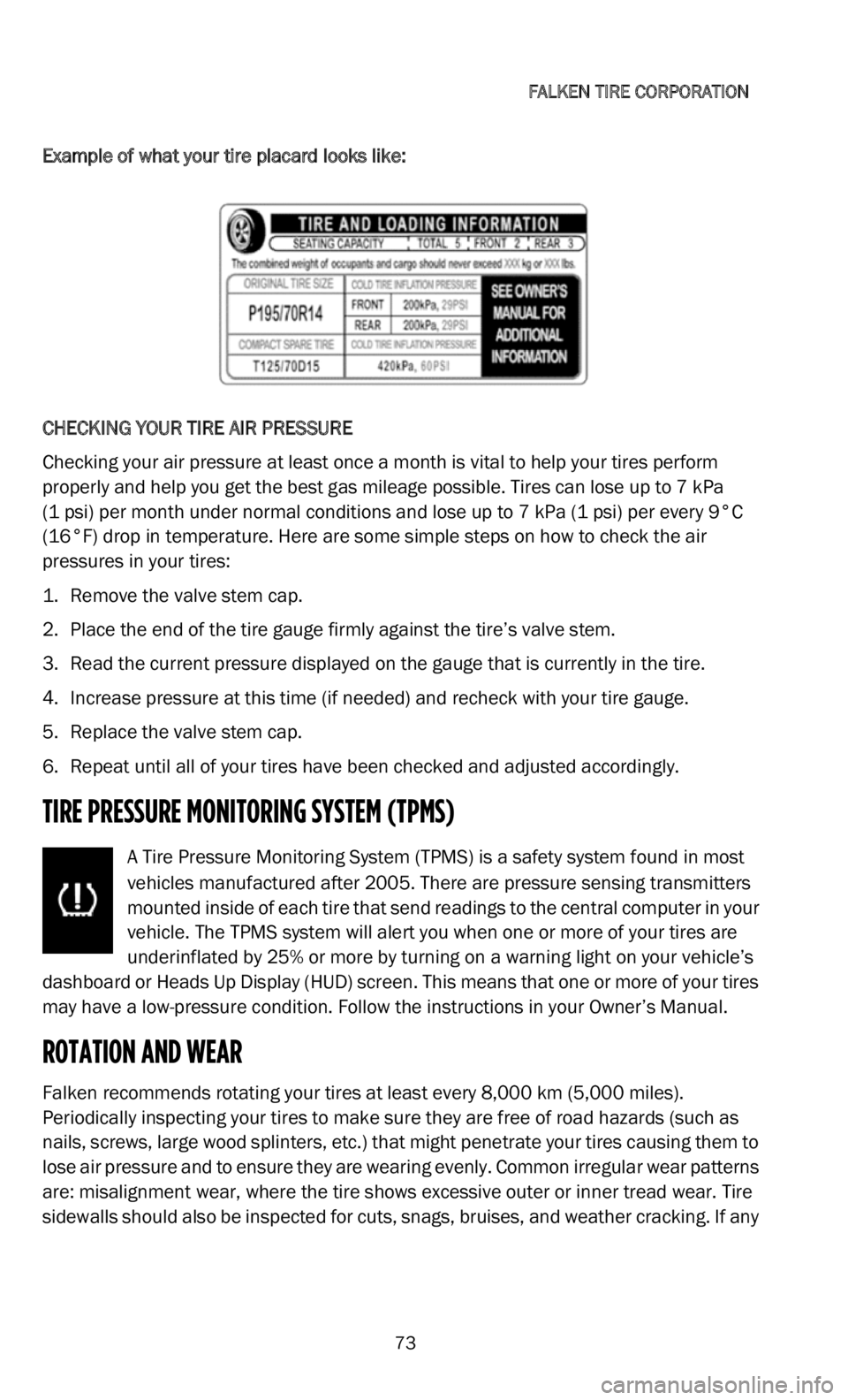TPMS DODGE DURANGO 2022 Vehicle Warranty
[x] Cancel search | Manufacturer: DODGE, Model Year: 2022, Model line: DURANGO, Model: DODGE DURANGO 2022Pages: 200, PDF Size: 6.72 MB
Page 12 of 200

TIRES
11
Tire Pressures For High Speed Operation
FCA US LLC advocates driving at safe speeds and within posted speed limits. Where
speed limits or conditions are such that the vehicle can be driven at high speeds,
maintaining correct tire inflation pressure is very important. Increased tire pressure and
reduced vehicle loading may be required for high-speed vehicle operation. Refer to an
authorized tire dealer or original equipment vehicle dealer for recommended safe
operating speeds, loading and cold tire inflation pressures.
Radial Ply Tires
Tire Repair
If your tire becomes damaged, it may be repaired if it meets the following criteria:
• The tire has not been driven on when flat.
• Th
e damage is only on the tread section of your tire (sidewall damage is not repair -
a b
le).
• The puncture is no greater than a ¼ of an inch (6 m
m).
Consult an authorized tire dealer for tire repairs and additional information.
Damaged Run Flat tires, or Run Flat tires that have experienced a loss of pressure should
be
replaced immediately with another Run Flat tire of identical size and service
description (Load Index and Speed Symbol).
Run Flat Tires — If Equipped
Run Flat tires allow you the capability to drive 50 miles (80 km) at 50 mph (80 km/h)
aft
er a rapid loss of inflation pressure. This rapid loss of inflation is referred to as the Run
Flat mode. A Run Flat mode occurs when the tire inflation pressure is of/or below 14 psi
(96 kPa). Once a Run Flat tire reaches the Run Flat mode, it has limited driving
capabilities and needs to be replaced immediately. A Run Flat tire is not repairable.
It is not recommended to drive a vehicle loaded at full capacity or to tow a trailer while a
tir
e is in the Run Flat mode.
See the Tire Pressure Monitoring System (TPMS) section for more information.
WARNING!
High speed driving with your vehicle under maximum load is dangerous. The added
strain on your tires could cause them to fail. You could have a serious collision. Do not
drive a vehicle loaded to maximum capacity at continuous speeds above 75 mph
(1 2
0 km/h).
WARNING!
Combining radial ply tires with other types of tires on your vehicle will cause your
vehicle to handle poorly. The instability could cause a collision. Always use radial ply
tires in sets of four. Never combine them with other types of tires.
Page 26 of 200

BFGOODRICH® TIRES
25
TIRE PRESSURE MONITORING SYSTEM (TPMS)
Your vehicle may be equipped with a Tire Pressure Monitoring System (TPMS) that is
designed to monitor the pressure of tires mounted on your vehicle and sends a signal to
the driver if a tire pressure falls below a predetermined level. A TPMS should not replace
monthly manual pressure checks for all four tires and the spare. We recommend that you
manually monitor and check tire pressure inflation with a pressure gauge.
Your tires should have the recommended pressure listed by your vehicle’s manufacturer.
Th
is information can be found in the vehicle Owner’s Manual and often on a placard
located in the vehicle’s door jamb, inside the fuel hatch, or on the glove compartment
door. If you have a plus size fitment that requires a higher inflation pressure, your TPMS
will require re-calibration to the new inflation pressure. Refer to your tire dealer/installer
of plus size tires for proper inflation pressure.
We recommend checking air pressure once each month, and before a long trip. Whether
y o
u have a full-sized or mini-spare, make sure that it is properly inflated as well. If the
TPMS generates improper monitoring or signals we recommend that you consult your
Owner’s Manual provided with your vehicle and follow up with FCA US LLC.
TIRE SPINNING
Do not spin wheels in excess of 35 mph (55 km/h) as indicated on the speedometer.
Ex
cessive speed in a free-running, unloaded tire can cause it to “explode” from
centrifugal force. The energy released by such an explosion is sufficient to cause serious
physical injury or death. Never allow anyone to stand near or behind the spinning tire.
When in mud, sand, snow, ice or other slippery conditions, do not engage in excessive
w h
eel spin. Accelerating the motor excessively, particularly with automatic transmission
vehicles, may cause a drive tire that has lost traction to spin beyond its speed capability.
This is also true when balancing a drive tire/wheel assembly on the vehicle using the
vehicle engine to spin the tire/wheel assembly.
HIGH SPEED DRIVING CAN BE DANGEROUS
Correct inflation pressure is especially important. However, at high speeds, even with the
correct inflation pressure, a road hazard, for example is more difficult to avoid and if
contact is made, has a greater chance of causing tire damage than at a lower speed.
Moreover, driving at high speed reduces the reaction time available to avoid accidents
and bring your vehicle to a safe stop.
If you see any damage to a tire or wheel, replace it with the spare at once and visit a
pa
rticipating BFGoodrich® Tire Retailer.
Exceeding the maximum speeds shown on the following page for each type of
B F
Goodrich® tire will cause the tire to build up excessive heat which can cause tire
damage that could result in sudden tire destruction and rapid air loss. Failure to control
a vehicle when one or more tires experience a sudden air loss can lead to an accident.
In any case, you should not exceed reasonable speeds as indicated by the legal limits
a n
d driving conditions.
Page 30 of 200

BFGOODRICH® TIRES
29
It is especially important to check the vehicle manufacturer’s Owner’s Manual when
mixing, matching or replacing tires on 4 Wheel Drive (4WD) vehicles, as this may require
special precautions.
BFGOODRICH® DOES NOT RECOMMEND MIXING SELF SUPPORTING STRUCTURE (SSS)
T I
RES WITH NON-SSS TIRES OTHER THAN THE TEMPORARY USE OF THE SPARE TIRE.
WINTER DRIVING
Tires which meet the Rubber Manufacturers Association (RMA) definition of snow tires
are marked M/S, M&S. On such tires, this designation is molded into the sidewall. Tires
without this notation are not recommended for winter driving.
While All-Season tires are designed to provide reliable performance in
some winter conditions, the use of four winter tires is recommended for
op
timum performance. Tires designated for use in severe winter
conditions are marked on at least one sidewall with the letter “M” and “S”
plus a pictograph of a mountain with a snowflake on it.
TIRE ROTATION AND REPLACEMENT
To obtain maximum tire wear, it may be necessary to rotate your tires. Refer to your
vehicle Owner’s Manual for instructions on tire rotation. If you do not have an Owner‘s
Manual for your vehicle, BFGoodrich® recommends rotating your tires every 6,000 to
8,000 miles (10,000 to 12,000 km).
Monthly inspection for tire wear is recommended. Your tires should be rotated at the first
s i
gn of irregular wear, even if it occurs before 6,000 miles (10,000 km). This is true for
a l
l vehicles.
When rotating tires with a directional tread pattern, observe the arrows molded on the
s i
dewall which show the direction the tire should turn. Care must be taken to maintain
the proper turning direction.
Some Tire Pressure Monitoring Systems (TPMS) may not recognize that a tire has been
m o
ved to a different position on your vehicle. Make certain that your TPMS system is
reset, if necessary, so as to correctly identify the location of each tire on your vehicle.
Refer to your vehicle Owner’s Manual or your vehicle dealer.
Determine whether rotated tires require tire inflation adjustment as front and rear
p o
sition tire pressure may vary according to the vehicle manufacturer’s specification due
to the actual load on that wheel position. Some vehicles may have different sized tires
mounted on the front and rear axles, and these different sized tires have rotation
restrictions. Always check the vehicle Owner’s Manual for the proper rotation
recommendations.
FULL-SIZE SPARE
Full-size spare tires (not temporary spares) of the same size and construction should be
used in a five tire rotation. Always check the inflation pressure of the full-size spare
immediately before incorporating it into rotation. Follow the vehicle manufacturer’s
recommended pattern for rotation, or if not available, see a qualified tire technician.
Page 53 of 200

BRIDGESTONE® - FIRESTONE®
52
If your spare is the same size, load rating, and type of tire as your road tires, it should be
included in the tire rotation process. For vehicles with a “full-size” spare, the following
rotation patterns may be used:
NOTE:
• Never include a “temporary use” spare tire in the rotation.
•
Tires with directional tread patterns must be rotated so the direction of revolution
d
oes not change; this may require demounting/mounting the tires.
• S pecial attention should be given if your vehicle is equipped with a Tire Pressure Moni -
t
oring System (TPMS). Rotation of your tires may affect the system; consult your
v e
hicle Owner’s Manual or a qualified tire service professional.
• S ome vehicles may have different size tires/wheels on front and rear which would
r
estrict rotation. Always check and follow the vehicle manufacturer’s rotation recom -
mendation.
• T o use a full-size spare in the rotation pattern on vehicles with dual rear wheels,
c
onsult your vehicle Owner’s Manual for the recommended procedures or consult the
vehicle manufacturer.
YOUR SPARE TIRE
Consult your vehicle Owner’s Manual for proper application of your spare tire. Your car
may be equipped with a “temporary use” spare tire; this spare may differ in size and
construction from the other tires on your vehicle.
WARNING!
Check inflation pressure before use. Failure to have proper inflation pressure when
using your spare tire can result in serious personal injury or death. See Tire Inflation
Pressure in this manual.
Page 55 of 200

BRIDGESTONE® - FIRESTONE®
54
TIRE REGISTRATION
Registration of your tires is an important safety precaution since it enables the
manufacturer to notify you in the event of a recall. When you purchase replacement tires,
the retailer will provide a registration card on which the tire identification numbers have
been recorded; fill in your name and address on the card and mail it promptly. Some
retailers may submit the registration for you. You do not need to register tires which come
as original equipment on new vehicles—the vehicle and tire manufacturers handle that
for you.
RFT TIRES WITH RUN-FLAT TECHNOLOGY
If your vehicle is equipped with Bridgestone® or Firestone® brand RFT
tires, this chapter presents specific maintenance and safety issues
a s
sociated with these tires that are in addition to those covered elsewhere in this
manual.
What is RFT? Run-Flat Technology tires are extraordinary tires that utilize specially
d e
signed components to temporarily support your vehicle in the event of inflation
pressure loss, such as from a puncture. This gives you the ability to drive to a convenient
and safe location to change your tire (if equipped with a spare) or have it inspected for
possible repair or replacement.
Naturally, certain run-flat and low pressure operating limitations apply, which varies
ac
cording to the specific self-supporting tire design. Like all tires, during normal
operation, they must be properly inflated and maintained. Regardless of the design or
quality, no tire is indestructible.
RFT — How to Identify: B
ridgestone® and Firestone® brand tires are marked on the
sidewalls, near the wheel, with the RFT logo (shown above).
RFT INFLATION PRESSURE
Like other tires, RFT tires need proper inflation pressure maintenance for safe operation
an
d to achieve the maximum tire life and performance. Check inflation pressures
monthly and before long trips or carrying extra weight. Use an accurate tire gauge and
check pressures when the tires are cold. Follow the vehicle manufacturer’s
recommendation for inflation pressure settings as indicated on the vehicle tire
information placard and/or in the vehicle Owner’s Manual. Do not forget the spare, if
applicable. See “Tire Inflation Pressure” in this manual.
TIRE PRESSURE MONITORING SYSTEM (TPMS)
A functioning Tire Pressure Monitoring System (TPMS) must be used with your Run Flat
tires. These tires ride so well even without inflation pressure, the TPMS may be necessary
to alert you of an inflation pressure loss condition. When alerted, follow the instructions
in your vehicle Owner’s Manual and see “Run-Flat or Low Tire Pressure Operation,” the
following section in this manual.
Page 56 of 200

BRIDGESTONE® - FIRESTONE®
55
The vehicle or TPMS manufacturer may advise checking the TPMS regularly to confirm it
is in working order. In addition, a new pressure sensor, certain components, or
reprogramming may be necessary when a tire is serviced. Consult your vehicle Owner’s
Manual, vehicle manufacturer, or a Bridgestone® Firestone® Run-Flat Certified Retailer
for questions regarding TPMS operation and service.
RUN-FLAT OR LOW TIRE PRESSURE OPERATION
General Instructions
The Tire Pressure Monitoring System (TPMS) required in your vehicle may have different
m e
thods of alerting you when your tire has lost inflation pressure. The international
standard for the definition of run-flat operation is pressure at or below 10 psi (70 kPa);
however, some vehicle manufacturers may have established a different pressure limit.
Consult your vehicle Owner’s Manual for the details of your TPMS. Once the TPMS has
indicated that a tire has reduced inflation pressure, the run-flat mode of operation has
commenced. During this phase of operation, please follow these instructions:
• Reduce speed as much as safely and reasonably possible; do not exceed 50 m
ph
(8
0 km/h). The greater the speed, the less distance the tire can travel.
• Avoid abrupt or aggressive acceleration, braking, or cornering maneuvers as much as
s
afely and reasonably possible. Pot holes and other road hazards should be avoided.
Careful driving limits potential damage to the tire, wheel, and vehicle.
• Proceed to a safe and convenient location for tire service as soon as possible.
Take
note of your mileage; your operation distance is limited. See "Distance—How Far You
Can Drive,” the next section in this manual.
• If an unusual vibration or vehicle handling difficulty arises, stop driving as soon as
s
afely and reasonably possible. The tire may be about to suddenly fail. Release the
accelerator and gradually reduce speed. The tire will need to be replaced before
proceeding.
• If towing a trailer, stop driving as soon as safely and reasonably possible. In this condi -
t
ion, it is potentially dangerous to operate a vehicle/trailer combination. I
f possible,
disconnect the trailer and proceed as noted above. Do not continue to tow any trailer
until proper tire service or replacement has been performed.
• Do not touch a tire recently run-low or run-flat (it may be very hot).
Allow the tire to cool
before handling.
WARNING!
Serious personal injury or death may result from a tire failure or accident due to
improper run-flat or low tire pressure operation. Read and follow the instructions
below, and the other maintenance and safety recommendations elsewhere in this
manual.
Page 57 of 200

BRIDGESTONE® - FIRESTONE®
56
DISTANCE—HOW FAR YOU CAN DRIVE
Factors affecting run-flat or low tire pressure operating distance include vehicle speed,
load, and maneuvering; the amount of inflation pressure loss; the extent of any tire
damage; and ambient temperature.
The tire may be marked on the sidewall with run-flat or low tire pressure operating speed
an
d/or distance limitations, which vary by tire design and vehicle application (consult
your vehicle owner’s manual). By international standard, RFT tires have a baseline
limitation in run-flat mode of the following:
NOTE:
• M aximum distance values are determined under controlled conditions, which may
v
ary in actual use.
• Y our mileage capability may be less, or more, depending on your specific operating
c
onditions.
• I f in doubt, do not exceed the 50
mile (80 km) limitation.
• S eek tire service as soon as possible to minimize tire damage.
SPECIAL SERVICE AND REPAIR ISSUES
Run-Flat Certified Retailers
Because of the advanced technology and design of Run-Flat tires and the required Tire
Pr
essure Monitoring Systems (TPMS), Bridgestone® Firestone® Run-Flat Certified
Retailers are specially trained to sell and service RFT tires.
Run-Flat Certified Retailers have the necessary equipment and are specially trained to
p r
operly mount and demount RFT tires and to handle TPMS devices. Conventional
mounting equipment may irreparably damage RFT tires and an improper repair is unsafe
and will void the Limited Warranty. Accordingly, it is important to go to a Bridgestone®
Firestone® Run-Flat Certified Retailer for tire maintenance and replacement.
Call toll-free 1-877-BFS-4RFT or, 87
7-237-4738 or visit www.bridgestonetire.com to
locate the nearest Bridgestone® Firestone® Run-Flat Certified Retailer.
Inspection after Run-Flat or Low Pressure Operation
Following run-flat or low tire pressure operation, or in the event of any other tire damage
or
unusual condition, it is very important to obtain a proper and complete tire evaluation
as soon as possible.
Rotation
Follow the vehicle manufacturer’s recommendations, or rotate every 5,000 miles per the
r e
commendations in this manual (see “Radial Tire Rotation”). In some cases, TPMS
devices require reprogramming with each tire rotation. Maximum Speed:
50 mph (80 km/h)
Maximum Distance: 50 miles (80 km)
Page 74 of 200

FALKEN TIRE CORPORATION
73
Example of what your tire placard looks like:
CHECKING YOUR TIRE AIR PRESSURE
Checking your air pressure at least once a month is vital to help your tires perform
p r
operly and help you get the best gas mileage possible. Tires can lose up to 7 kPa
(1 psi) per month under normal conditions and lose up to 7 kPa (1 psi) per every 9°C
( 1
6°F) drop in temperature. Here are some simple steps on how to check the air
pressures in your tires:
1. R emove the valve stem cap.
2
. P lace the end of the tire gauge firmly against the tire’s valve stem.
3
. R ead the current pressure displayed on the gauge that is currently in the tire.
4
. I ncrease pressure at this time (if needed) and recheck with your tire gauge.
5
. R eplace the valve stem cap.
6
. R epeat until all of your tires have been checked and adjusted accordingly.
TIRE PRESSURE MONITORING SYSTEM (TPMS)
A Tire Pressure Monitoring System (TPMS) is a safety system found in most
vehicles manufactured after 2005. There are pressure sensing transmitters
mo
unted inside of each tire that send readings to the central computer in your
vehicle. The TPMS system will alert you when one or more of your tires are
underinflated by 25% or more by turning on a warning light on your vehicle’s
dashboard or Heads Up Display (HUD) screen. This means that one or more of your tires
may have a low-pressure condition. Follow the instructions in your Owner’s Manual.
ROTATION AND WEAR
Falken recommends rotating your tires at least every 8,000 km (5,000 miles).
Pe
riodically inspecting your tires to make sure they are free of road hazards (such as
nails, screws, large wood splinters, etc.) that might penetrate your tires causing them to
lose air pressure and to ensure they are wearing evenly. Common irregular wear patterns
are: misalignment wear, where the tire shows excessive outer or inner tread wear. Tire
sidewalls should also be inspected for cuts, snags, bruises, and weather cracking. If any
Page 95 of 200

GOODYEAR® DUNLOP® TIRES
94
WHAT IS NOT COVERED BY THIS WARRANTY?
This limited warranty does not cover the following:
• Tires submitted for ride disturbance complaints that are worn beyond the first 2/32 of
a
n inch tread depth or tires submitted for ride disturbance due to damaged wheels or
any vehicle condition.
• G oodyear® does not warrant or give credit in any adjustment transaction for any kind
o
f material added to a tire (e.g., tire fillers, sealants, balancing substances) after the
tire leaves a factory producing Goodyear® or Dunlop® tires, nor will it adjust any tire
that has failed as a result of adding such material.
• I rregular wear or damage due to mechanical condition of the vehicle, improper infla -
t
ion, overloading, high speed spin-up, misapplication, misuse, negligence, racing, use
o f
tire chains, improper mounting or demounting, improper repair, wreck, collision or
fire.
• R oad hazards (includes, but is not limited to, punctures, cuts, snags, impact breaks,
e
tc.).
• A ny tire that, after leaving a factory producing Goodyear® or Dunlop® tires, has been
i
ntentionally altered to change its appearance (e.g., white inlay on a black tire or
regrooved).
• T ires with weather-cracking that were purchased more than four years prior to presen -
t
ation for adjustment or, if purchase date cannot be verified, manufactured more than
f o
ur years prior to presentation for adjustment.
• T emporary spare tires used on vehicles used in racing and on passenger cars in
s
pecial applications such as police pursuit service.
• G oodyear® Unisteel® Commercial Radial Light Truck Tires.
•
Tires removed from service due to improper repairs.
•
Tires supplied as Original Equipment are not eligible for any tread life warranty consid -
e
ration.
• C osmetic weather checking.
•
Tire Pressure Monitoring System (TPMS) – refer to vehicle manufacturer’s warranty.
•
Ultra High-Performance Summer tires are not recommended for Winter use, and tread
o
r shoulder cracking on those tires resulting from Winter use will not be covered under
our warranty.
WHAT ARE YOUR LEGAL RIGHTS?
No Representative or dealer has authority to make any representation, promise or
agreement on behalf of Goodyear®, except as stated herein. Any tire, no matter how well
constructed, may fail in service or otherwise become unserviceable due to conditions
beyond the control of the manufacturer. Under no circumstances is this warranty a
representation that a tire failure cannot occur.
DISCLAIMER: THIS WARRANTY IS IN LIEU OF, AND GOODYEAR® HEREBY DISCLAIMS,
AN
Y AND ALL OTHER WARRANTIES AND REPRESENTATIONS, EXPRESS OR IMPLIED,
Page 96 of 200

GOODYEAR® DUNLOP® TIRES
95
INCLUDING WITHOUT LIMITATION ANY WARRANTY OF MERCHANTABILITY OR FITNESS
FOR A PARTICULAR PURPOSE, AND NO OTHER WARRANTY OR REPRESENTATION OF ANY
KIND IS MADE BY GOODYEAR® OR SHALL BE IMPLIED BY LAW.
LIMITATION OF DAMAGES: IN NO EVENT AND UNDER NO CIRCUMSTANCE SHALL
G O
ODYEAR® BE LIABLE TO THE BUYER FOR ANY INDIRECT, SPECIAL, INCIDENTAL,
CONSEQUENTIAL, LOST PROFIT, LOSS OF BUSINESS, LOSS OF GOODWILL OR
REPUTATION, PUNITIVE OR OTHER DAMAGE, COST (INCLUDING FOR REPLACEMENT
TRANSPORTATION), EXPENSE OR LOSS OF ANY KIND. SOME STATES AND PROVINCES
DO NOT ALLOW THE EXCLUSION OR LIMITATION OF INCIDENTAL OR CONSEQUENTIAL
DAMAGES, SO THE ABOVE LIMITATION OR EXCLUSION MAY NOT APPLY TO YOU.
This warranty gives you specific legal rights and you may also have other rights that vary
f r
om state to state or province to province.
HOW DO YOU OBTAIN AN ADJUSTMENT?
1. You must present the tire to be adjusted to an authorized Goodyear® or Dunlop® service facility. Tires replaced on an adjustment basis become the property of The
Goodyear® Tire & Rubber Company or Goodyear® Canada Inc.
2. Y ou must pay for taxes and any additional services you order at the time of adjust -
m
ent plus any additional service that may be unique to your application, e.g., Tire
P r
essure Monitoring System (TPMS).
3. Y ou must submit your claim on an approved claim form supplied by an authorized
G
oodyear® or Dunlop® service facility. The form must be filled out completely and
signed, where you the owner or an authorized agent presented the tire for adjust -
ment. You must go to an authorized Goodyear® or Dunlop® outlet for replacement
t i
res and all warranty service.
SAFETY WARNINGS
Property damage, serious injury or death may result from:
• TIRE FAILURE DUE TO UNDERINFLATION/OVERLOADING/ MISAPPLICATION.
Follow
the vehicle Owner’s Manual or tire placard in vehicle.
• TIRE FAILURE DUE TO IMPACT DAMAGE/IMPROPER MAINTENANCE.
Tires should be
inspected regularly by a qualified technician for signs of damage, such as punctures
or impacts.
• TIRE FAILURE DUE TO IMPROPER REPAIRS. See US Tire Manufactuers Association
(
USTMA) established repair procedures at https://www.ustires.org/ and/or go to
www.goodyear.com for information on proper repair procedures.
• EXPLOSION OF TIRE/RIM ASSEMBLY DUE TO IMPROPER MOUNTING.
Only specially
trained persons should mount tires.
• FAILURE TO MOUNT RADIAL TIRES ON APPROVED RIMS.
• FAILURE TO DEFLATE SINGLE OR DUAL ASSEMBLIES COMPLETELY BEFORE
D
EMOUNTING.